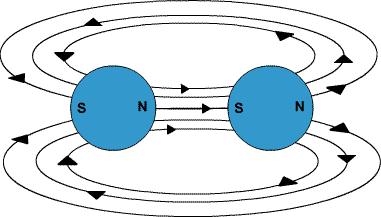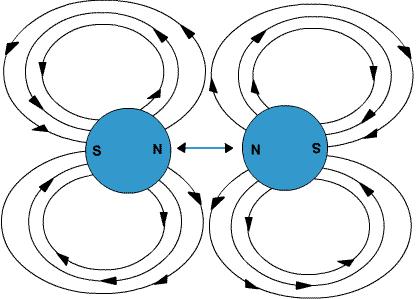Site pages
Current course
Participants
General
MODULE 1. Magnetism
MODULE 2. Particle Physics
MODULE 3. Modern Physics
MODULE 4. Semicoductor Physics
MODULE 5. Superconductivty
MODULE 6. Optics
LESSON 1. Basic concept of Magnetism & its terminology
Introduction
Magnetism is a force of attraction or repulsion that acts at a distance. It is due to a magnetic field, which is caused by moving electrically charged particles. It is also inherent in magnetic objects such as a magnet.
A magnet is an object that exhibits a strong magnetic field and will attract materials like iron to it. Magnets have two poles, called the north (N) and south (S) poles. Two magnets will be attracted by their opposite poles, and each will repel the like pole of the other magnet. Magnetism has many uses in modern life.
Questions you may have include:
What is a magnetic field?
What is a magnetic force?
What is the relationship between magnetism and electricity?
Magnetic field
A magnetic field consists of imaginary lines of flux coming from moving or spinning electrically charged particles. Examples include the spin of a proton and the motion of electrons through a wire in an electric circuit.
What a magnetic field actually consists of is somewhat of a mystery, but we do know it is a special property of space.

Fig.1(1) Magnetic field or lines of flux of moving charged particle
Names of poles
The lines of magnetic flux flow from one end of the object to the other. By convention, we call one end of a magnetic object the N or North-seeking pole and the other the S or South-seeking pole, as related to the Earth's North and South magnetic poles. The magnetic flux is defined as moving from N to S.
Note: The Earth does not follow the magnetic configuration in the above illustration. Instead, the lines of flux are opposite from a moving charged particle.
Magnets
Although individual particles such as electrons can have magnetic fields, larger objects such as a piece of iron can also have a magnetic field, as a sum of the fields of its particles. If a larger object exhibits a sufficiently great magnetic field, it is called a magnet.
Magnetic force
The magnetic field of an object can create a magnetic force on other objects with magnetic fields. That force is what we call magnetism.
When a magnetic field is applied to a moving electric charge, such as a moving proton or the electrical current in a wire, the force on the charge is called a Lorentz force.
Attraction
When two magnets or magnetic objects are close to each other, there is a force that attracts the poles together.

Fig.1(2) Force attracts N to S
Magnets also strongly attract ferromagnetic materials such as iron, nickel and cobalt.
Repulsion
When two magnetic objects have like poles facing each other, the magnetic force pushes them apart.

Fig.1(3) Force pushes magnetic objects apart
Magnetic and electric fields
The magnetic and electric fields are both similar and different. They are also inter-related.
Electric charges and magnetism similar
Just as the positive (+) and negative (−) electrical charges attract each other, the N and S poles of a magnet attract each other.
In electricity like charges repel, and in magnetism like poles repel.
Electric charges and magnetism different
The magnetic field is a dipole field. That means that every magnet must have two poles.
On the other hand, a positive (+) or negative (−) electrical charge can stand alone. Electrical charges are called monopoles, since they can exist without the opposite charge.
Magnetic Flex density (B)
If the total numbers of lines of forces comprising the magnetic field is called the magnetic flux , then the magnetic flux density is defined as the flux is passing per unit area within a material through a plane at right angles to the flux and is given by
\[B={\varphi \over A}{{Wb} \over {{m^2}}}\]
The magnetic flux density is also proportional to the intensity of the magnetic field H
Hence, B \[\propto\] H = \[\mu H\]
Where,\[\mu\] is a constant known as permeability and depens on the magnetic nature of the medium. In the absence of any medium, B \[\propto\] H = \[\mu H\] is given by
\[B = {\mu _o}H\]
Where, \[{\mu _o}\] is absolute permeability of free space and is equal to \[4\pi\times{10^{ - 7}}{H \over m}\]
The ratio \[{\mu\over{{\mu _o}}}\] is called a relative permeability \[{\mu _r}\], and is dimensionless quantity.
Magnetism is a class of physical phenomena that includes forces exerted by magnets on other magnets.
\[{\mu _r}\] = \[{\mu\over{{\mu _o}}}\]
Hence \[\mu\] = \[{\mu _o}\] \[{\mu _r}\]
Hence B = \[{\mu _o}\] \[{\mu _r}\]H
Intensity of magnetic field
The intensity (strength) of magnetic field at any point within a field is measured by the magnitude of a force experienced by a unit N pole placed at that point.
Suppose a positive pole of strength + m Wb experiences a force of Newton at any point in the magnetic field, and then the intensity of the field at that point is
\[H={F\over m}{N\over{W{b^{ - 1}}}}\]
The intensity of magnetic field has a definite direction at every point acts along the lines which are called the magnetic lines of force.
Intensities of magnetization (H)
Adding and subtracting \[{\mu _o}\]H from B = \[{\mu _o}\]\[{\mu _r}\]H , We get
B = \[{\mu _o}\]\[{\mu _r}\]H + \[{\mu _o}\]H - \[{\mu _o}\]H
Hence B = \[{\mu _o}\]H + \[{\mu _o}\]H(\[{\mu _r}\] - 1) the first term is magnetic flux density in free space and the second term gives the indication of increase in flux density due to the magnetic material.
The quantity H (\[{\mu _r}\] - 1) = M is called the intensity of magnetization and equal to the magnetic moment per unit volume.
\[H\left({{\mu _r} - 1} \right)=M\]
Magnetic Susceptibility
The ratio between the intensity of magnetization M to the intensity of magnetic field is known as magnetic susceptibility Xm
Hence \[{\chi _m}={M \over H}=\left( {{\mu _r} - 1}\right)\]